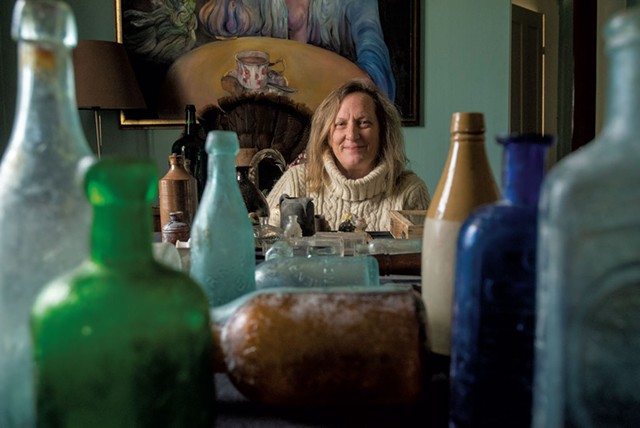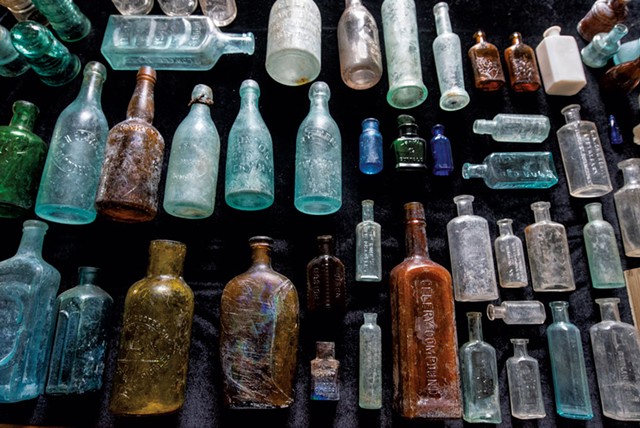
- Jeb Wallace-Brodeur
- Laura Smith-Riva
The idea of digging around her property for buried treasures first came to Laura Smith-Riva in a dream. But it took some groundhogs to turn that dream into reality.
In 2018, Smith-Riva and her husband, Vincenzo Riva, bought an 1823 farmhouse and land on Berlin Street in Montpelier. Two years later, Smith-Riva was standing in her yard on their hilly, 10-acre sheep farm when she spotted something glimmering in the sun: a perfectly square glass bottle that the groundhogs had unearthed. She dug it up, washed it and, upon researching it, determined that it was a perfume bottle from the 1920s.
Later, her husband mentioned that he'd discovered an old trash dump in one corner of their property; such dumps were common on Vermont farms in the years before municipal landfills. So, in the midst of the pandemic lockdown, Smith-Riva decided to see what else lay buried there.
"I spent that summer digging that out and finding all kinds of cool stuff," she recalled. "From there, the hobby just kind of took off."
Soon, Smith-Riva's home and garage were filled with an assortment of found objects she'd dug up on her property and those of friends: buttons, marbles, tobacco pipes, medallions, dolls, electric insulators and porcelain figurines.
Mostly, though, she turned up old glass bottles, some of which date back to the mid-1800s. Among her favorites are those embossed with the names of products they once contained: Dead Shot for Bed Bugs; Dr. Kilmer's Swamp Root Kidney Liver & Bladder Cure; Bunker Hill Pickles; Kendall's Spavin Cure for Human Flesh. Many were Vermont-made remedies that contained now-prohibited compounds such as opium, laudanum and cocaine; a few were over-the-counter abortifacients.
Though the bottles are now empty and their paper labels have long since decomposed, they offer a snapshot of the daily lives of Vermonters who once lived there and the products they used. There's a thriving trade in old bottles and other historic items, which are often sold at antique stores and flea markets and online. While the practice of digging for them is legal on private land, archaeologists charged with protecting the integrity of historic sites are concerned when the market for such items drives prospectors to scavenge on state-owned land and in public waterways.
Smith-Riva is one of dozens of Vermont hobbyists known as bottle diggers. Though many do it as a side hustle — an old bottle can sell for anywhere from $10 to $10,000 — Smith-Riva is primarily a collector.
"I'm not in it for the money," she said. "I just love finding the old glass."
Smith-Riva regularly posts photos, videos and historical details of her findings on her Instagram account, @middenmaidenvt, and now has more than 770 under the title Vecchia bottiglia — Italian for "old bottle." One such video, shot by her digging buddy, Jeremy Berquist, has been viewed more than 25,000 times.
"It's just a video of an old bottle being pulled out of the ground," she said. But Smith-Riva isn't surprised that something so seemingly mundane attracts so much curiosity.
"It's the sense of the reveal. There's the anticipation of what is it and then seeing this old thing come up out of the ground," she explained. "That's just something that people feel drawn to. I know I did."
A Jericho native, Smith-Riva, 59, grew up in an 1832 farmhouse and did some similar scavenging as a child. She and her siblings often played in an old trash dump across the road from their house and pulled bottles from a nearby river.
"I always wanted to be an archaeologist when I was a kid," she said. "But it wasn't exactly the kind of career path that was generally encouraged by parents from the Greatest Generation."
Years later, while living with her husband in Danville, Smith-Riva dreamed that a little girl was living on her property. In the dream, Smith-Riva was riding on the tailgate of a pickup truck when the girl came running after her and handed her a small figurine that she'd dug up from the ground.
At the time, the dream had no obvious significance to Smith-Riva. Years later, though, while digging on her farm in Montpelier, she unearthed an ivory-colored porcelain figurine known as a "Frozen Charlotte" doll, which many diggers collect. According to a National Park Service website, Frozen Charlottes are small, one-piece dolls that were first manufactured in Germany, then later in Britain and elsewhere, between 1850 and 1920. The name originated from a Victorian-era folk ballad about a young woman who froze to death during a carriage ride to a winter's ball.
At the time she had the dream, Smith-Riva had never seen or heard of a Frozen Charlotte. But, coincidentally, she has an alternative healing practice, called Archetypical Dreamworks, in which she helps clients understand the significance of their dreams and what their subconscious might be trying to tell them.

- Jeb Wallace-Brodeur
- A portion of Laura Smith-Riva's collection of items from digs around the state
"It was quite a synchronicity when I started this hobby and found the first Frozen Charlotte doll, and then I remembered the dream that I had," she said. "[In] a lot of the work that's happening in a dreamwork session, you're excavating the past," such as childhood traumas or longtime patterns of behavior that the client wants to change.
Though Smith-Riva doesn't believe that dreams have universal interpretations, she suggested that they can reveal unfulfilled aspirations — in her case, perhaps a childhood desire to become an archaeologist.
These days, Smith-Riva goes out digging about once a week, often with Berquist, whom she met through a local Facebook group. The two regularly spend three to five hours excavating a site, at times digging 12 feet deep. Some days, their outings yield buckets of old bottles; other days, just one or two.
Regardless of what they find, the process has reaped other rewards. Early on, Smith-Riva realized that her political views and those of Berquist were on opposite ends of the spectrum.
"We don't talk politics a lot," she said. "But we found common ground and got to know each other, so we can respect each other for who we are."
Not all diggers are as cooperative, and many are very protective of their dig sites because of the hot market for historic bottles, especially those made in Vermont. Tim Camisa, who owns 802 Antiques in South Burlington's University Mall, regularly sells old Vermont glass brought to him by local bottle diggers.
"I've probably got six or eight of them who come in," he said. "It's gratifying to pull something out [of] the ground."
As Camisa explained, the bottles' prices are based on their shape, color, age and rarity. For example, a good spring water bottle can fetch $1,000 to $5,000, he said, while a flask from the 1840s to 1860s can run anywhere from $500 to $15,000.
"Putting price tags on historic items from Vermont's past is not something we condone or engage in," said Jess Robinson, state archaeologist with the Vermont Division for Historic Preservation. Robinson emphasized that he isn't "scolding" collectors such as Smith-Riva, who are perfectly within their right to excavate dumps on their own land and other private property, then sell it.
"Curiosity about the human past through material remains is extremely important and makes us understand our world more," he added.

- Jeb Wallace-Brodeur
- Some of the bottles from Laura Smith-Riva's collection
But whether people plan to sell these items or simply display them on a shelf, Robinson pointed out, diggers need to know that it's illegal to gather artifacts without permission on any publicly owned property. That includes municipal, state and federal land, as well as navigable waterways below their normal high-water mark. It's also illegal to disturb burial sites or human remains, regardless of their location.
If diggers find something they think is significant, Robinson recommended that they take a photo with a smartphone, document the GPS coordinates and send them to him. Unless it's at imminent threat of being washed down a river or destroyed by development, he advises leaving it in place, both for its long-term preservation and for future archaeologists.
For her part, Smith-Riva emphasized that she never digs on public land and never on private property without the owners' permission. But she feels good about many of the items she's found, such as a tiny stone watering can, once common in canary cages. Though she knows nothing of this one's origins, such cages were used in the late 1800s and early 1900s by Chinese railroad laborers, who often kept canaries.
Another prize find: a 1928 copper medallion, made to commemorate the U.S. Army Ambulance Corps in World War I.
"I feel like we're rescuing history," she said. "If bottle diggers weren't doing this, archaeologists wouldn't be doing it. This stuff wouldn't be coming up out of the ground."
Assuming, of course, that the groundhogs don't unearth it first.




Comments
Comments are closed.
From 2014-2020, Seven Days allowed readers to comment on all stories posted on our website. While we've appreciated the suggestions and insights, right now Seven Days is prioritizing our core mission — producing high-quality, responsible local journalism — over moderating online debates between readers.
To criticize, correct or praise our reporting, please send us a letter to the editor or send us a tip. We’ll check it out and report the results.
Online comments may return when we have better tech tools for managing them. Thanks for reading.